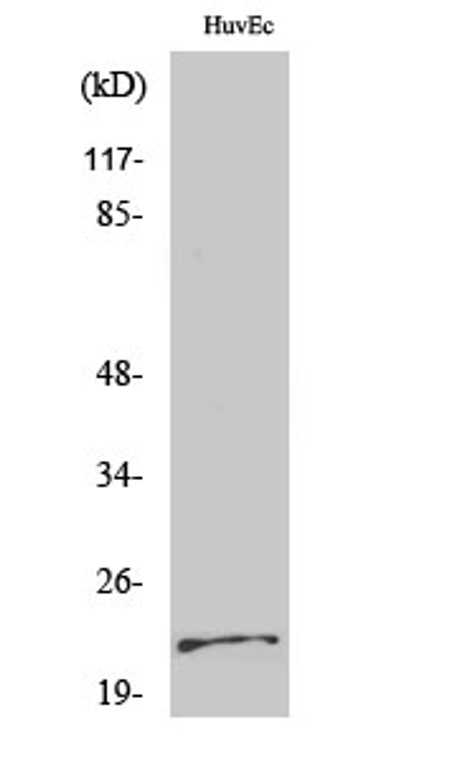| Host: |
Rabbit |
| Applications: |
WB/IHC/IF/ELISA |
| Reactivity: |
Human/Mouse |
| Note: |
STRICTLY FOR FURTHER SCIENTIFIC RESEARCH USE ONLY (RUO). MUST NOT TO BE USED IN DIAGNOSTIC OR THERAPEUTIC APPLICATIONS. |
| Short Description: |
Rabbit polyclonal antibody anti-Parkinson disease protein 7 (21-70 aa) is suitable for use in Western Blot, Immunohistochemistry, Immunofluorescence and ELISA research applications. |
| Clonality: |
Polyclonal |
| Conjugation: |
Unconjugated |
| Isotype: |
IgG |
| Formulation: |
Liquid in PBS containing 50% Glycerol, 0.5% BSA and 0.02% Sodium Azide. |
| Purification: |
The antibody was affinity-purified from rabbit antiserum by affinity-chromatography using epitope-specific immunogen. |
| Concentration: |
1 mg/mL |
| Dilution Range: |
WB 1:500-1:2000IHC 1:100-1:300IF 1:200-1:1000ELISA 1:10000 |
| Storage Instruction: |
Store at-20°C for up to 1 year from the date of receipt, and avoid repeat freeze-thaw cycles. |
| Gene Symbol: |
PARK7 |
| Gene ID: |
11315 |
| Uniprot ID: |
PARK7_HUMAN |
| Immunogen Region: |
21-70 aa |
| Specificity: |
PARK7 Polyclonal Antibody detects endogenous levels of PARK7 protein. |
| Immunogen: |
The antiserum was produced against synthesized peptide derived from the human DJ-1 at the amino acid range 21-70 |
| Post Translational Modifications | Sumoylated on Lys-130 by PIAS2 or PIAS4.which is enhanced after ultraviolet irradiation and essential for cell-growth promoting activity and transforming activity. Cys-106 is easily oxidized to sulfinic acid. Undergoes cleavage of a C-terminal peptide and subsequent activation of protease activity in response to oxidative stress. |
| Function | Multifunctional protein with controversial molecular function which plays an important role in cell protection against oxidative stress and cell death acting as oxidative stress sensor and redox-sensitive chaperone and protease. It is involved in neuroprotective mechanisms like the stabilization of NFE2L2 and PINK1 proteins, male fertility as a positive regulator of androgen signaling pathway as well as cell growth and transformation through, for instance, the modulation of NF-kappa-B signaling pathway. Has been described as a protein and nucleotide deglycase that catalyzes the deglycation of the Maillard adducts formed between amino groups of proteins or nucleotides and reactive carbonyl groups of glyoxals. But this function is rebuted by other works. As a protein deglycase, repairs methylglyoxal- and glyoxal-glycated proteins, and releases repaired proteins and lactate or glycolate, respectively. Deglycates cysteine, arginine and lysine residues in proteins, and thus reactivates these proteins by reversing glycation by glyoxals. Acts on early glycation intermediates (hemithioacetals and aminocarbinols), preventing the formation of advanced glycation endproducts (AGE) that cause irreversible damage. Also functions as a nucleotide deglycase able to repair glycated guanine in the free nucleotide pool (GTP, GDP, GMP, dGTP) and in DNA and RNA. Is thus involved in a major nucleotide repair system named guanine glycation repair (GG repair), dedicated to reversing methylglyoxal and glyoxal damage via nucleotide sanitization and direct nucleic acid repair. Protects histones from adduction by methylglyoxal, controls the levels of methylglyoxal-derived argininine modifications on chromatin. Able to remove the glycations and restore histone 3, histone glycation disrupts both local and global chromatin architecture by altering histone-DNA interactions as well as histone acetylation and ubiquitination levels. Displays a very low glyoxalase activity that may reflect its deglycase activity. Eliminates hydrogen peroxide and protects cells against hydrogen peroxide-induced cell death. Required for correct mitochondrial morphology and function as well as for autophagy of dysfunctional mitochondria. Plays a role in regulating expression or stability of the mitochondrial uncoupling proteins SLC25A14 and SLC25A27 in dopaminergic neurons of the substantia nigra pars compacta and attenuates the oxidative stress induced by calcium entry into the neurons via L-type channels during pacemaking. Regulates astrocyte inflammatory responses, may modulate lipid rafts-dependent endocytosis in astrocytes and neuronal cells. In pancreatic islets, involved in the maintenance of mitochondrial reactive oxygen species (ROS) levels and glucose homeostasis in an age- and diet dependent manner. Protects pancreatic beta cells from cell death induced by inflammatory and cytotoxic setting. Binds to a number of mRNAs containing multiple copies of GG or CC motifs and partially inhibits their translation but dissociates following oxidative stress. Metal-binding protein able to bind copper as well as toxic mercury ions, enhances the cell protection mechanism against induced metal toxicity. In macrophages, interacts with the NADPH oxidase subunit NCF1 to direct NADPH oxidase-dependent ROS production, and protects against sepsis. |
| Protein Name | Parkinson Disease Protein 7Maillard DeglycaseOncogene Dj1Parkinsonism-Associated DeglycaseProtein Dj-1Dj-1Protein/Nucleic Acid Deglycase Dj-1 |
| Database Links | Reactome: R-HSA-3899300Reactome: R-HSA-9613829Reactome: R-HSA-9615710Reactome: R-HSA-9646399 |
| Cellular Localisation | Cell MembraneLipid-AnchorCytoplasmNucleusMembrane RaftMitochondrionEndoplasmic ReticulumUnder Normal ConditionsLocated Predominantly In The Cytoplasm AndTo A Lesser ExtentIn The Nucleus And MitochondrionTranslocates To The Mitochondrion And Subsequently To The Nucleus In Response To Oxidative Stress And Exerts An Increased Cytoprotective Effect Against Oxidative DamageDetected In Tau Inclusions In Brains From Neurodegenerative Disease PatientsMembrane Raft Localization In Astrocytes And Neuronal Cells Requires Palmitoylation |
| Alternative Antibody Names | Anti-Parkinson Disease Protein 7 antibodyAnti-Maillard Deglycase antibodyAnti-Oncogene Dj1 antibodyAnti-Parkinsonism-Associated Deglycase antibodyAnti-Protein Dj-1 antibodyAnti-Dj-1 antibodyAnti-Protein/Nucleic Acid Deglycase Dj-1 antibodyAnti-PARK7 antibody |
Information sourced from Uniprot.org
12 months for antibodies. 6 months for ELISA Kits. Please see website T&Cs for further guidance










